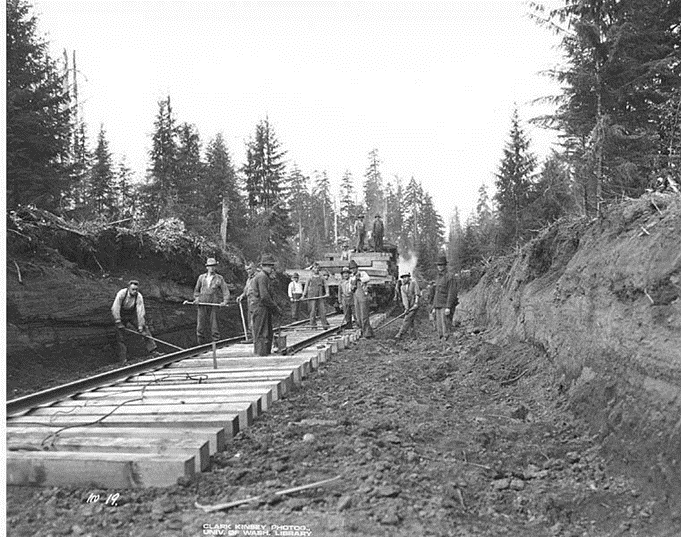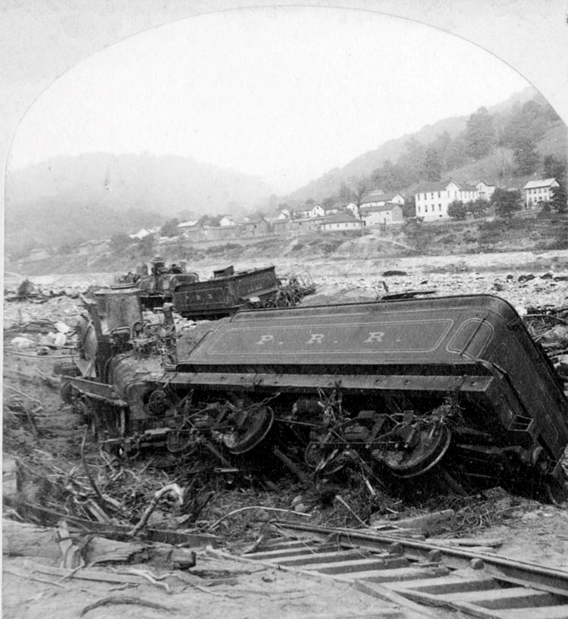History of the Railroads Article 7

Working For The Railroad
The following article are excerpts of a story as told by Mr. John Grosvenor by Frederick W. Kaul and L.A. Rollins for a Federal Writers Project. John tells his story of working for the Central Missouri Railroad.
With this article you will be able to see how tracks were laid, their upkeep and repair. Procedures and steps for the train’s safety after the flooding of the tracks. What can happen, such as washouts and destabilization of the roadbed and its seriousness.
Here is John’s story.
In 1880, John needed a job to feed his family. He had a homestead but could not make a living off it.
So, one afternoon, after having dinner at his father’s farm, four miles north of Logan, Kansas. Afterwards, John took off to find a badly needed job. Having walked eighteen miles, it was later in the afternoon when he found a job by finishing digging out a cellar which paid 50 cents in wages. Having brought with him seventy-five cents it gave him a stake to live off of until he found a job and got paid.
Before he went to bed that night, he had found a job with the newly completed Central Missouri Pacific Railroad for a dollar a day. He had to furnish his own accommodations, so he found a house to rent. He sent word to his wife that he would be home next Sunday to bring her back with him.
The work schedule was 10 hours a day, 6 days a week. After having worked that Saturday’s shift, he walked eighteen miles back home. They packed their stuff into a wagon and made their way back to the place he had rented and went to work first thing Monday morning.

Locomotive similar to what would have been used here
Pacific Railroad Locomotive Charles H. Peck 1869
Author unknown Public Domain through Wiki Commons
The work was hard. When they said ten hours of work, they expected ten big hours as John had classified working there.
John had acquired his farm through the Homestead Act of 1862. Through it, any person, if they had never borne arms against the United States, could claim up to 160 acres of land for a small filing fee. You had to maintain five years of continuous residence, build a home, and make improvements to the land.
He had to work on the railroad so he would have a stake to buy food while staying there.
So, John had worked for the railroad as long as he could and had to go back to his farm to maintain his eligibility. After spending the required time to hold on to his place, John went back to work on the railroad on April 1, 1882, for $1.10 a day.

Work crew laying railroad rack Coats-Fordney Lumber Company, ca. 1921
Clark Kinsey, Public domain, via Wikimedia Commons
It turned out that 1882 was a very wet year. The section of track that John was assigned was prone to flooding. So much so was that when a big rain came, all hands on that section had to report to work that next morning. As the train came through, the section crews were in front of the train pushing the hand car. Of course, the train would follow just barely creeping along.
They were checking for soft spots in the ballast roadbed or washouts. Either one would cause the train to derail. When they found either, they would wave the flag, stopping the train so they could repair the track.

Shows several Pennsylvania Railroad engines overturned near railroad tracks
Library Company of Philadelphia, No restrictions, via Wikimedia Commons
No Known Restrictions Flickr Commons
The above picture shows the devastation of a flood in My 31, 1889 on the Pennsylvania Railroad. One would think that these heavy locomotives would stay put, but flooding takes anything in its path. Even locomotives weigh tons.
This would go on for miles, where there was one and a half feet of water covering the track.
They would keep going through the night, using lanterns to see. For three days and three nights they worked, finding over 3 miles of track that had been washed out.
They got help and repaired the washed-out tracks. It rained the entire time and in places it was between 1 1/2 feet to over a man's head deep.

Railroad track near Plainfield, IA (photography: Don Becker, USGS)
PDRailroad track near Plainfield, IA (photography: Don Becker, USGS)
U.S. Geological Survey from Reston, VA, USA, CC0, via Wikimedia Commons
To repair the track, the rails had to be jacked up. They used timber, lumber, polls, iron along with anything else needed to fix the track. They would only use light trains and slowly get them through.
The men did not have any rain gear, so the men remained soaked the entire time. Also, food was in short supply. When they finally got home the men were so completely exhausted.
They received time and a half for the night work. With the rain continuing the entire month, they received almost double their wages for that month.
There was an ecological downside to all the rain. Ducks and frogs flooded the area, as well as the rain. John stated that millions of the animals came to the track and stayed. The noise was so deafening that some of the men had trouble with their hearing for weeks.
Reference:
-
Federal Writers Project by Frederick W. Kaul and L.A. Rollins Hasting, Nebraska, as told by Mr. John Grosvenor of hasting Nebraska “The New Railroad”